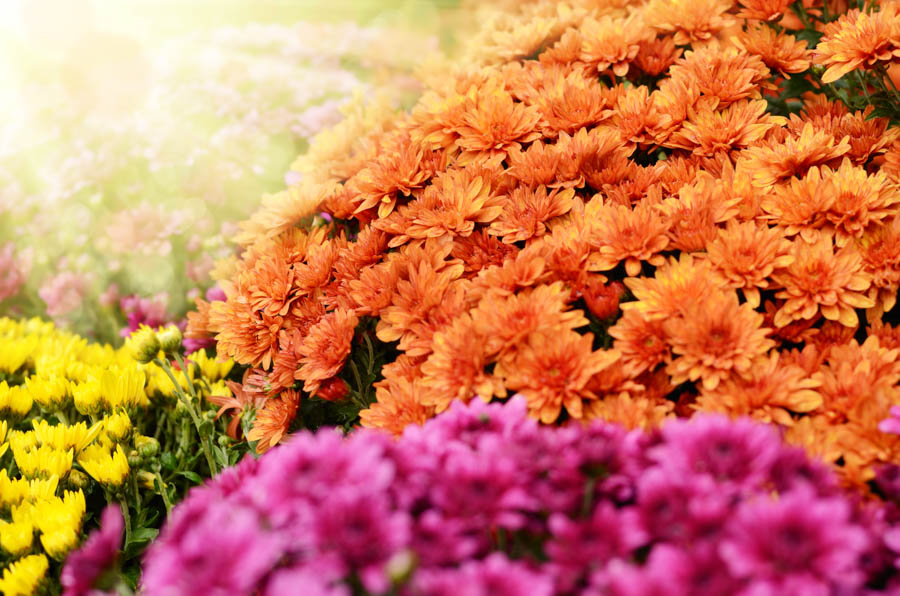Glorious Chrysanthemums: Caring for Potted Florist Mums

Florist chrysanthemums in gloriously beautiful and varied colors and flower forms often appear en masse for sale in autumn, and for holiday decoration such as for Easter and Thanksgiving. Mums are commonly sold as houseplants and as gift flowers year-round everywhere from garden centers and grocery markets to farmers markets and roadside stands in mild-climate California areas.
The varied colors and forms of chrysanthemum flowers range from delicate and lovely to stunning and irresistible. Chrysanthemum flower colors cover the spectrum from simple white to an endless range of pinks, reds and maroon through deep burgundy, yellow and gold, orange to bronze, violet and purple, and even green. In 2017, Japanese scientists created the first true-blue chrysanthemums through genetic engineering. Many chrysanthemum varieties are available that bloom in two or more colors. The National Chrysanthemum Society in the United States has identified 13 classes or types of chrysanthemum flower based on bloom and floret form, including multiple forms of globular bloom, single and semi-double, pompom, anemone, spoon, quill, spider, brush or thistle, and unclassified or exotic.
Care for florist mums is simple. Those who live in areas with mild daytime and nighttime temperatures can grow mums outdoors: place mums in an area receiving five or more hours of morning sun, but afternoon shade. Unless outdoor daytime and nighttime temperatures are mild, it’s best to keep florist mums indoors. Whether indoors or outdoors, they need regular watering, with well-drained, moist-but-not-wet soil that dries at the soil surface between waterings. Avoid wetting leaves. Most mums bloom best and hold blooms longest at temperatures of about 65° to 80°F and with several hours of direct sunlight or bright indoor light throughout the day but with darkness at night. Bloom period may be shortened if mums have insufficient light or are exposed to light overnight, such as from a porch light or indoor light. Deadhead spent flowers to extend blooming period and to maintain an attractive appearance.
Florist mums typically bloom for a few-to-several weeks. It’s possible but difficult to encourage reblooming of chrysanthemums, and different varieties and cultivars vary in their exact requirements for reblooming.
Will potted florist chrysanthemums survive and rebloom if planted outdoors? That depends. In general, chrysanthemums grow in warm summer weather then bloom in response to the shorter days of fall. However, florist mums are often “forced” or put into bloom outside of their natural seasonal period and may not bloom again outdoors until specific conditions are met during their normal blooming season. Chrysanthemums are heavily hybridized, with endless varieties and cultivars. Characteristics and cultivation needs including seasonal blooming and heat tolerance vary by cultivar. If you want to plant your florist mums outdoors in your garden after blooms are spent, it’s worth checking the cultivation needs and tolerances of varieties before purchasing. Florist mums generally do not tolerate cold winters or extended hard frosts. Many mild-summer, mild-winter California areas provide a suitable climate for florist mums to grow and bloom naturally outdoors. Blooming may be sparse or sporadic for transplanted florist mums even when climate and growing conditions are suitable. Many florist chrysanthemums survive hot temperatures for periods in the 90s or hotter, especially with shade during hot afternoons, but temperatures may interrupt or prevent blooming.
With the uncertainties and challenges for reblooming, the relatively low expense of purchasing fresh florist mums, and the many related species in the Asteraceae family that are more reliable in home gardens, the rewards for investing time and effort into transplanting florist mums outdoors may be comparatively minimal. But if you’re a curious or adventurous gardener, or simply have a spare spot or two in your perennial beds and want to tuck in your florist mums after bloom cycles are spent, you might be pleasantly surprised by fresh or repeated blooms over the next year or two.
Other articles of interest:
Caring for Chinese Lantern Plants (Physalis alkekengi)